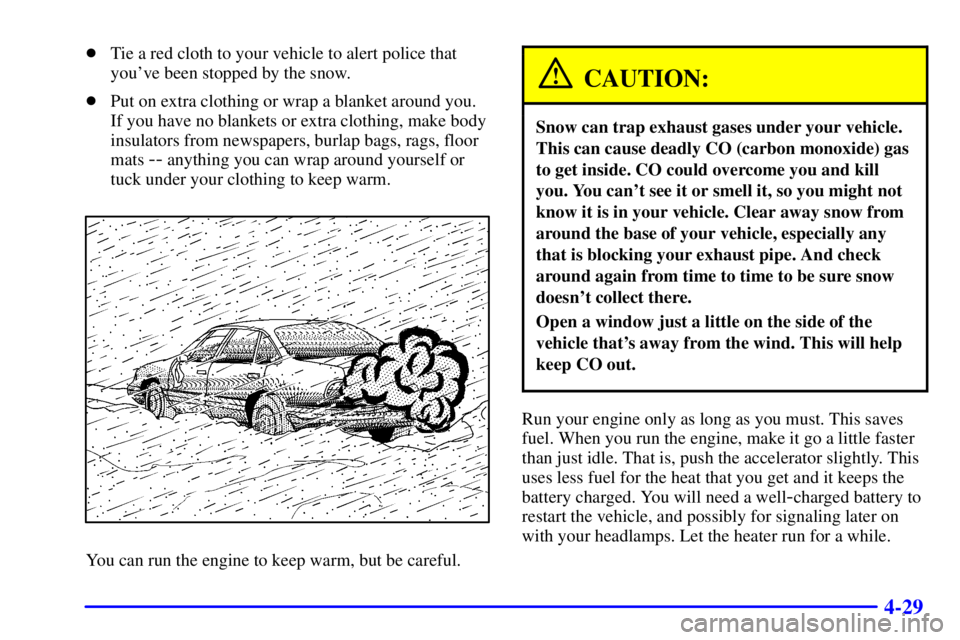Page 2 of 402
Free lockout assistance
Free dead-battery assistance
Free out-of-fuel assistance
Free flat-tire change
Emergency towing
1-800-762-3743
(For vehicles purchased in Canada,
call
1-800-268-6800)
that provides in an emergency:
1-800-762-3743
(For vehicles purchased in Canada,
call
1-800-268-6800)
Bumper-to-Bumper
3-years/36,000 miles (60 000 km)
Limited Warranty
Courtesy
Transportation
Every
2000 Bonneville
under warranty is
backed with the
following
services:
Page 233 of 402

4-29
�Tie a red cloth to your vehicle to alert police that
you've been stopped by the snow.
�Put on extra clothing or wrap a blanket around you.
If you have no blankets or extra clothing, make body
insulators from newspapers, burlap bags, rags, floor
mats
-- anything you can wrap around yourself or
tuck under your clothing to keep warm.
You can run the engine to keep warm, but be careful.
CAUTION:
Snow can trap exhaust gases under your vehicle.
This can cause deadly CO (carbon monoxide) gas
to get inside. CO could overcome you and kill
you. You can't see it or smell it, so you might not
know it is in your vehicle. Clear away snow from
around the base of your vehicle, especially any
that is blocking your exhaust pipe. And check
around again from time to time to be sure snow
doesn't collect there.
Open a window just a little on the side of the
vehicle that's away from the wind. This will help
keep CO out.
Run your engine only as long as you must. This saves
fuel. When you run the engine, make it go a little faster
than just idle. That is, push the accelerator slightly. This
uses less fuel for the heat that you get and it keeps the
battery charged. You will need a well
-charged battery to
restart the vehicle, and possibly for signaling later on
with your headlamps. Let the heater run for a while.
Page 249 of 402
5-6
5. Check that the jumper cables don't have loose or
missing insulation. If they do, you could get a shock.
The vehicles could also be damaged.
Before you connect the cables, here are some basic
things you should know. Positive (+) will go to
positive (+) and negative (
-) will go to a heavy,
unpainted metal engine part or a body metal surface.
Don't connect positive (+) to negative (
-) or you'll
get a short that would damage the battery and maybe
other parts, too. Also, don't connect the negative (
-)
cable to the negative (
-) terminal on the dead battery.
CAUTION:
Fans or other moving engine parts can injure you
badly. Keep your hands away from moving parts
once the engine is running.
6. Connect the red positive
(+) cable to the remote
positive (+) terminal of
the vehicle with the
dead battery.
Page 250 of 402
5-7
7. Don't let the other end
of the cable touch metal.
Connect it to the
positive (+) terminal of
the good battery. Use a
remote positive (+)
terminal if the vehicle
has one.8. Now connect the black
negative (
-) cable to
the good battery's
negative (
-) terminal.
Don't let the other end touch anything until the next
step. The other end of the negative (
-) cable doesn't
go to the dead battery.
Page 251 of 402
5-8
It goes to a heavy,
unpainted metal engine
part on the vehicle with
the dead battery.
9. Now start the vehicle with the good battery and run
the engine for a while.
10. Try to start the vehicle with the dead battery.
If it won't start after a few tries, it probably
needs service.
11. Remove the cables in reverse order to prevent
electrical shorting. Take care that they don't touch
each other or any other metal. Replace the red
positive (+) remote terminal cover to its
original position.
Removal Procedure
A. Remote Positive (+) Terminal
B. Good Battery
C. Windshield Washer Bottle Stud (not shown in
picture
-- located on the passenger's side corner
of the engine compartment)